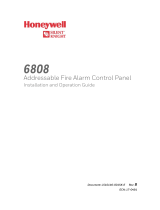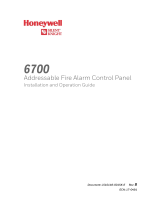Page is loading ...

©1997-2017 Trikdis 2 www.trikdis.com
Wireless I/O expander iO-WL & iO-MOD
Content
SAFETY REQUIREMENTS ........................................................................................................................................ 2
1. DESCRIPTION ................................................................................................................................................. 3
1.1. TECHNICAL PARAMETERS .................................................................................................................................... 3
1.2. LIGHT INDICATION OF OPERATION ......................................................................................................................... 4
2. ADD IO-WL TO COMMUNICATOR USING TRIKDISCONFIG ............................................................................. 4
2.1. CONFIGURE IO-WL MODULE ............................................................................................................................... 4
3. SET SUBSYSTEM FOR IO-WL AND IO-MOD ..................................................................................................... 5
4. CONNECT IO-WL MODULE TO COMMUNICATOR USING DIAGRAMS BELLOW ............................................... 6
Safety Requirements
The security alarm system should be installed and maintained by qualified personnel.
Prior to installation, please read carefully this manual in order to avoid mistakes that can lead to malfunction or even
damage to the equipment.
Disconnect power before making any electrical connections.
Changes, modifications or repairs not authorized by the manufacturer shall void your rights under the warranty.
Please act according to your local rules and do not dispose of your unusable alarm system or its components
with other household waste.

©1997-2017 Trikdis 3 www.trikdis.com
Wireless I/O expander iO-WL & iO-MOD
1. Description
iO-WL wireless expander with iO-MOD RF module expands the number of inputs and outputs on G16
communicator using two – way wireless RF communication. This expander allows connecting and
controlling remotely digital temperature sensors, heating, AC, gates or other equipment in the
upgraded system.
Compatible Trikdis devices:
Communicator G16
Communicator G16T
Communicator/controller CG17
Features
1.1. Technical Parameters
Parameter
Description
Wireless I/O expander iO-WL:
Transmission frequency
868 MHz
Modulation type
GFSK
Power supply
10-28VDC
Current consumption
50 mA (on standby)
Up to 150 mA (while sending data)
Message encryption
Yes
Range in open space
Up to 300 m
Inputs
1, selectable type NC/NO
Relay output
Commutating up to 250 VAC, 4A max
Temperature sensors
1, DS18B20 or DS18S20
Operating environment
Temperature from -10 °C to 50 °C, relative humidity – up to 80% at +20 °C
Communicator dimensions
65 x 77 x 25 mm
iO-MOD RF module:
Transmission frequency
868 MHz
Power supply
10-28VDC
Current consumption
50 mA (on standby)
Up to 150 mA (while sending data)
Range in open space
Up to 300 m
Operating environment
Temperature from -10 °C to 50 °C, relative humidity – up to 80% at +20 °C
Communicator dimensions (with
antenna)
12 x 3 mm
Inputs and outputs
1 Wire bus for temperature sensors
1 selectable type input, type: NC or NO
1 relay output
Connection
Connection to communicator via:
Wireless connection via iO-MOD, or
RS-485
Communications
Monitoring and Control:
Protegus Mobile/Web application, allowing user to
remotely monitor and control alarm system
Wireless operating range in the area of direct visibility up to
300 m
Possible to connect 8 expanders to one communicator.
The Signal Strength Indicator (SSI) allows installers, during
installation, to view the radio transmission signal strength on
wireless devices in real time.

©1997-2017 Trikdis 4 www.trikdis.com
Wireless I/O expander iO-WL & iO-MOD
1.2. Light indication of operation
Indicator
Light Status
Description
Wireless I/O expander iO-WL:
Power
Green solid
Power supply is on with sufficient voltage
Yellow blinking
Operating is normal
Output
Green solid
Output relay reacted
Data
Green solid
Communication with communicator
Yellow blinking
Indicates wireless connection strength (1 – 10 flashes)
iO-MOD RF module:
Power
Green solid
Power supply is on with sufficient voltage
Yellow blinking
Operating is normal
Data
Green blinking
Communication with communicator
2. Add iO-WL to communicator using TrikdisConfig
Note: To find more information on how to configure communicator with TrikdisConfig, see the
communicator’s installation manual.
1. Power supply must be disconnected
2. Connect communicator to TrikdisConfig software using USB or remotely.
3. Go to RS485 modules windows.
4. Select module (module iO-WL) from modules list,
a. Enter the serial six digit number (this number is mandatory for communication, it can be found on
the device casing or packing box).
Note: if more than one module are used in the system, select them from the list and set their parameters.
5. New tab (Module x) for each module will appear.
2.1. Configure iO-WL module
In the tab Module x, configure parameters of the iO-WL module. Here, set input mode, temperature range for
digital temperature sensor and output control settings.

©1997-2017 Trikdis 5 www.trikdis.com
Wireless I/O expander iO-WL & iO-MOD
Serial – mandatory serial six-digit number (set previous step).
Input mode – choose an input operation type (NC or NO) from the list.
Output control – set output reaction when selected conditions occurs.
Event table – if required enable/disable events, change type from Event to Restore, enter CID, Partition
(Part.) and Zone codes.
If digital temperature sensor will be used, set parameters:
o Max °C (T1) – maximum allowable temperature value, above which an event will be reported. For
such purpose event named HIGH_TEMPERATURE must be enabled.
o Min °C (T2) – minimum allowable temperature value, below which the situation will be reported. For
such purpose event named LOW_TEMPERATURE must be enabled.
3. Set subsystem for iO-WL and iO-MOD
It is important to choose the same subsystems for both devices (iO-MOD and iO-WL), otherwise, connection
would not be established between them. If nearby another RF system is installed, it is necessary that those
systems would have different switcher positions, to ensure that communication would not be interfered.
To pair devices follow these steps:
1. Take of casings from devices (as shown in the pictures below).
2. Move both switches to the same position (places of switches is marked in the pictures c)).
3. Close devices and if modules is set not for first time - restart the device.
Find a switcher (marked) and make
sure, that iO-MOD and iO-WL
switchers are set in the same
position.
Gently push screwdriver to
the left side and front casing
should easily take off.
Module from the front
Use flat screwdriver to take of
front cover. Put screwdriver’s
head to the marked slot.
Hold bottom casing part tightly.
Open iO-WL module:
Marked switcher place
DO NOT turn around module after taking
back cover.
Find a switcher (marked) and make sure,
that iO-MOD and iO-WL switchers are set
in the same position.
Use cross screwdriver to
unscrew (counter clockwise)
screws and then take of back
cover.
Turn around module.
Module from the front
Module from the back
Marked switcher place
Open iO-MOD module:

©1997-2017 Trikdis 6 www.trikdis.com
Wireless I/O expander iO-WL & iO-MOD
4. Connect iO-WL module to communicator using diagrams bellow
Input connection types
NC, Normally Closed
NO, Normally Open
Note:
When connecting more than one sensor with longer than 0.5 m wires, it is recommended to use twisted pair
cable (UTP, STP).
Maximum four iO-MOD modules with their own subsystems can be connected to one communicator in one
system
Maximum eight modules can be in one system
iButton reader compatible only with CG17 communicator
/








